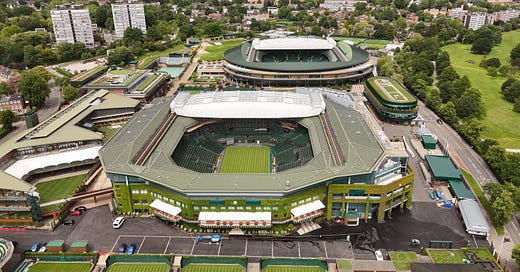Wimbledon and the transatlantic class system
“The only thing championship about Wimbledon is its prestige”, John McEnroe
Wimbledon still retains the air of an iconic tennis tournament.
But it is not just a tennis tournament. It reflects tradition and transformation.
What once felt like a sleepy corner of the English summer, with its strawberries and clink of Pimm’s or Champagne glasses, has become one of the clearest lenses through which to observe the global economy of taste, class, and power.
In recent years, the fashion press has circled Centre Court with almost the same intensity as the sports pages.
There’s a reason for that. Wimbledon has emerged as a ritual site for the transatlantic style elite, a platform where a particular vision of civility is performed, photographed, and exported.
It’s not only about the players, it’s about who’s in the box, what they’re wearing, and what those choices signal to the watching world.
Since 2006, Ralph Lauren has outfitted Wimbledon’s umpires, ball kids, and officials.
The designs, crest-bearing blazers, cable-knit vests, cricket whites, are unmistakably drawn from Ivy League and preppy archives.
The effect is less local gentry, more global prep. It’s a fascinating fusion: American aspiration woven into British ritual.
And it works. Ralph Lauren is tapping into what Douglas Holt would call myth markets. At Wimbledon, those myths are worn as uniform.
This cross-Atlantic blending is not incidental. In network terminology, Wimbledon has positioned itself as the most refined node in the global leisure circuit, like the Oscars, a cultural product somewhere between The Hamptons, St. Moritz and a Soho House opening.
You don’t need to understand tennis to understand what this space communicates. The optics are clear: order, legacy, etiquette, taste.
But behind the tailoring, there is significant infrastructure layered onto the All-England Tennis Event.
Sponsorship deals with Rolex (a partner for 50years), Lavazza, Evian, Emirates.
Each name tells a story. Rolex signals heritage and restraint.
Emirates brings in the weight of Gulf capital.
This all suggests that Wimbledon is no longer a purely English affair. It is a transnational stage for soft power, where capital, culture and class quietly converge.
On opening day this year, a heat wave (temporary) broke out and temperatures broke 32 degrees.
Yet the dress code held firm.
David Beckham in Hugo Boss. Eddie Redmayne in cream tailoring and an Omega.
Vogue’s dispatch read like a red carpet digest. But the real story lies in the choreography. Wimbledon has become one of the few remaining events where the elite can still rehearse civility in public.
The atmosphere is never loud, never casual. Even its celebrities dress as functionaries of decorum.
This kind of pageantry has consequences. Wimbledon is beautiful as it is iconic, but it is also visually and physically exclusionary.
The calm, the cleanliness, the creased linen, all speak to a kind of symbolic control. It is high fashion as border policy.
It tells us who belongs, and how, just as Bourdieu did.
That doesn’t mean it’s all sinister.
The elegance is real. The tennis has some genuine superstars, amongst its ranks, such as Alcaraz, Sinner, Sabalenka and Gauff.
But what is fascinating, politically and culturally, is how Wimbledon disguises global power relations as heritage style.
The Emirati airline, the Swiss watch, the American designer, the Royal Box, all harmonised in cream, all bathed in nostalgia.
Sport becomes pageant, fashion becomes a uniform, and taste becomes a soft currency of belonging.
Wimbledon, in its current form, is not just about who wins the tournament.
It’s about who gets to appear, and how. In this sense, it’s not a sporting event at all.




